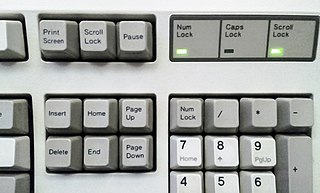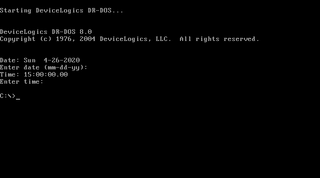Related Research Articles

Scroll Lock is a lock key on most IBM-compatible computer keyboards. Depending on the operating system, it may be used for different purposes, and applications may assign functions to the key or change their behavior depending on its toggling state. The key is not frequently used, and therefore some reduced or specialized keyboards lack Scroll Lock altogether.

In computer data storage, drive letter assignment is the process of assigning alphabetical identifiers to volumes. Unlike the concept of UNIX mount points, where volumes are named and located arbitrarily in a single hierarchical namespace, drive letter assignment allows multiple highest-level namespaces. Drive letter assignment is thus a process of using letters to name the roots of the "forest" representing the file system; each volume holds an independent "tree".

DR-DOS is a disk operating system for IBM PC compatibles. Upon its introduction in 1988, it was the first DOS that attempted to be compatible with IBM PC DOS and MS-DOS.
Bytecode is a form of instruction set designed for efficient execution by a software interpreter. Unlike human-readable source code, bytecodes are compact numeric codes, constants, and references that encode the result of compiler parsing and performing semantic analysis of things like type, scope, and nesting depths of program objects.

In DOS memory management, the high memory area (HMA) is the RAM area consisting of the first 65520 bytes above the one megabyte in an IBM AT or compatible computer.

In computing, configuration files are files used to configure the parameters and initial settings for some computer programs or applications, server processes and operating system settings.
A fat binary is a computer executable program or library which has been expanded with code native to multiple instruction sets which can consequently be run on multiple processor types. This results in a file larger than a normal one-architecture binary file, thus the name.
CONFIG.SYS is the primary configuration file for the DOS and OS/2 operating systems. It is a special ASCII text file that contains user-accessible setup or configuration directives evaluated by the operating system's DOS BIOS during boot. CONFIG.SYS was introduced with DOS 2.0.
AUTOEXEC.BAT is a system file that was originally on DOS-type operating systems. It is a plain-text batch file in the root directory of the boot device. The name of the file is an abbreviation of "automatic execution", which describes its function in automatically executing commands on system startup; the filename was coined in response to the 8.3 filename limitations of the FAT file system family.
ANSI.SYS is a device driver in the DOS family of operating systems that provides extra console functions through ANSI escape sequences. It is partially based upon a subset of the text terminal control standard proposed by the ANSI X3L2 Technical Committee on Codes and Character Sets.
IO.SYS is an essential part of MS-DOS and Windows 9x. It contains the default MS-DOS device drivers and the DOS initialization program.

IBMDOS.COM is the filename of the DOS kernel. Loaded and initially invoked by the DOS BIOS in IBMBIO.COM during the boot process, it contains the hardware-independent parts of the operating system, including the embedded FAT12, FAT16 and, in newer versions, the FAT32 file system code, as well as the code to provide the DOS API to applications.
Computer hardware or software is said to be bug compatible if it exactly replicates an undesirable feature of a previous version. The phrase is found in the Jargon File.

MSCDEX or Microsoft CD-ROM Extensions is a software program produced by Microsoft and included with MS-DOS 6.x and certain versions of Windows to provide CD-ROM support. Earlier versions of MSCDEX since 1986 were installable add-ons for MS-DOS 3.1 and higher.

DOS is a family of disk-based operating systems for IBM PC compatible computers. The DOS family primarily consists of IBM PC DOS and a rebranded version, Microsoft's MS-DOS, both of which were introduced in 1981. Later compatible systems from other manufacturers include DR-DOS (1988), ROM-DOS (1989), PTS-DOS (1993), and FreeDOS (1998). MS-DOS dominated the IBM PC compatible market between 1981 and 1995.

The Windows 9x series of operating systems refers to the monolithic kernel which powers these operating systems. The basic code is similar in function to MS-DOS. As a 16-/32-bit hybrid, it requires support from MS-DOS to operate.
In computing, a hardware code page (HWCP) refers to a code page supported natively by a hardware device such as a display adapter or printer. The glyphs to present the characters are stored in the alphanumeric character generator's resident read-only memory and are thus not user-changeable. They are available for use by the system without having to load any font definitions into the device first. Startup messages issued by a PC's System BIOS or displayed by an operating system before initializing its own code page switching logic and font management and before switching to graphics mode are displayed in a computer's default hardware code page.

MS-DOS 7 is a real mode operating system for IBM PC compatibles. Unlike earlier versions of MS-DOS, it was not released separately by Microsoft, but included in the Windows 9x family of operating systems. Windows 95 RTM reports it as MS-DOS 7.0, and Windows 95 OSR 2.x and Windows 98 report as 7.1. The real-mode MS-DOS 7.x is contained in the IO.SYS file.
References
- ↑ "Exactly What Is A Driver?". OSR. 2003-05-14. Archived from the original on 2007-09-28.
- ↑ "Contents of the Windows Msdos.sys File". Support. Microsoft. 2004-09-27. Archived from the original on 2004-10-20.
- ↑ "What is an Config.sys file?". www.dewassoc.com. Archived from the original on 2011-06-29. Retrieved 2007-02-16.
- 1 2 Paul, Matthias R. (2001-06-10) [1995]. "DOS COUNTRY.SYS file format" (COUNTRY.LST file) (1.44 ed.). Archived from the original on 2016-04-20. Retrieved 2016-08-20.
- ↑ Paul, Matthias R. (2001-12-30). "KEYBOARD.SYS internal structure". comp.os.msdos.programmer. Archived from the original on 2017-09-09. Retrieved 2016-09-17.
[...] In fact, the format is basically the same in MS-DOS 3.3 - 8.0, PC DOS 3.3 - 2000, including Russian, Lithuanian, Chinese and Japanese issues, as well as in Windows NT, 2000, and XP [...]. There are minor differences and incompatibilities, but the general format has not changed over the years. [...] Some of the data entries contain normal tables [...]. However, most entries contain "executable code" interpreted by some kind of P-code interpreter at *runtime*, including conditional branches and the like. This is why the KEYB driver has such a huge memory footprint compared to table-driven keyboard drivers which can be done in 3 - 4 Kb getting the same level of functionality except for the interpreter. [...]
- ↑ Mendelson, Edward (2001-07-20). "How to Display the Euro in MS-DOS and Windows DOS". Display the euro symbol in full-screen MS-DOS (including Windows 95 or Windows 98 full-screen DOS). Archived from the original on 2016-09-17. Retrieved 2016-09-17.
[...] Matthias [R.] Paul [...] warns that the IBM PC DOS version of the keyboard driver uses some internal procedures that are not recognized by the Microsoft driver, so, if possible, you should use the IBM versions of both KEYB.COM and KEYBOARD.SYS instead of mixing Microsoft and IBM versions [...]
(NB. What is meant by "procedures" here are some additional byte codes in the IBM KEYBOARD.SYS file not supported by the Microsoft version of the KEYB driver.) - ↑ "SYS File Extension - What is an .sys file and how do I open it?". fileinfo.com.